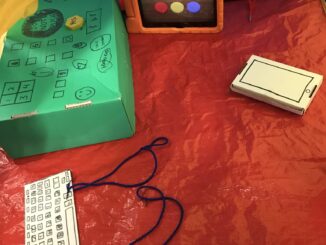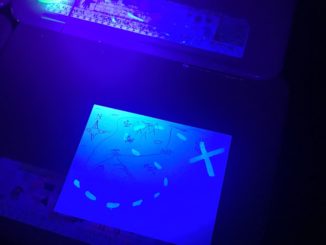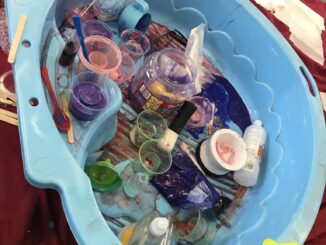I think early childhood education has misunderstood what is behind the concept of “using the right pencil grasp”.
For example, in my child’s reception class (the UK equivalent of preschool/kindergarten — it’s not exactly 1:1 with US standards), they had the four stages of pencil grasp posted on the wall, and they had little stickers with each kid’s name, so that the adults could note exactly which grasp every child was using and know if they had progressed to a “mature grasp” yet, and try to encourage them about where to place their fingers on the pencil if they hadn’t.
As another example, I’ve seen lots of “tips and tricks” online, like making your child only use triangular crayons until they have a mature grasp, or making them only use small bits of chalk or crayon in order to encourage them to pinch it with three fingers, or things like that.
None of these things are bad, necessarily, but they’re also missing a little bit of the underlying reason why children’s grasp develops the way it does, so let me try to explain that to you today.
Grasp while writing/drawing is usually a reflection of what joint the child is using to control the pencil.
People hold a pencil in a “mature” tripod grasp when they are controlling the pencil using only their finger joints. Pick up a pencil right now, or imagine you’re holding one, and try to draw or mimic drawing the shape of letters using only your fingers but keeping your wrist, elbow, and shoulder completely still. You can do that (most likely) because you are an adult.
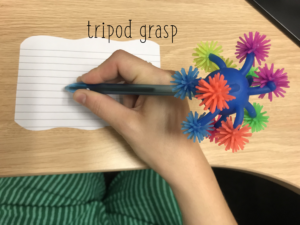
Now hold the pencil or hold the imaginary pencil in a “palmar grasp” — a closed fist. Obviously you cannot move it with your fingers as they are in a closed fist. Even moving just your wrist is unlikely. It’s more likely that if you tried to make letters you’d be using either your elbow or your shoulder to move your whole forearm as if it’s one frozen unit.
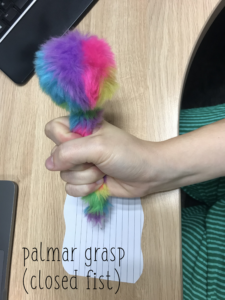
Kids use “immature” grasps and progress through them as they develop muscle control in the smaller and smaller parts of their arm. First they have good muscle control in their upper arm, then their lower arm, then their hand, then their fingers, etc — like as they grow and develop.
Usually, this means that they progress from holding the writing utensil with a closed fist and controlling it with their shoulder or elbow moving their whole arm as a unit, to holding it with sort of a rotated arm and extending maybe one pointer finger as they try to work on getting a little bit of wrist control and even finger control in there but aren’t doing it super efficiently yet (but the pointer finger usually has more practice being used than the other fingers do yet!), and then eventually into a tripod grasp where they’re using three fingers or a quadruped grasp where they’re using four fingers to control the writing utensil.
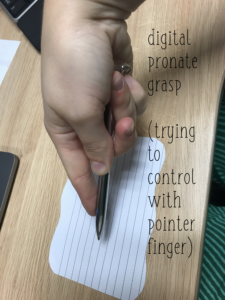
(Technically a tripod grasp is “most mature”. I personally use a quadruped grasp when I write, by default — if that tells you anything about how desperately important it is to use only a tripod to be a successful human being in life 
Kids will probably use whichever joint/muscle group that feels most intuitively confident in their body to be able to produce the kind of work they’re trying to produce — so a kid might hold with a “better” (more mature) grasp when they scribble because the scribbling doesn’t take all their mental energy and a scribble can be easily produced by just moving at the wrist, but then the exact same kid might revert to a “worse” (more immature) grasp when they write letters because they’re being asked to do a higher-level thing and they might even understand that thing mentally, but not be ready to do that with their fingertips yet — not have high enough coordination yet.
Another factor is how the writing surface is oriented, and what size it is. A vertical surface in front of a child, like an easel or drawing on a brick wall with chalk, is going to change the child’s body mechanics compared to a horizontal, flat surface. A large surface is going to typically encourage large body movements, and so a child might instinctually use a more secure grasp like a closed fist, because they already know that in order to draw as big as they want, they’re going to be using their shoulder or their elbow anyway. That’s okay too. Imagine taking a whiteboard marker and using it to draw a big huge “A” on a whiteboard, like, half the size of your body. You might instinctually hold the whiteboard marker in a tripod grasp because you’re used to years of holding writing utensils that way, but you don’t actually need the tiny muscle control of your fingertips to write a big giant A. You could probably be equally successful holding it in a closed fist grasp, because you’re moving your whole shoulder and arm.
Okay so now you understand what’s going on, what’s underlying pencil grasp.
All of this doesn’t mean that using triangular crayons is bad or that using small chalk or small pencils is bad or anything like that. None of it is bad. When these tools naturally guide kids to grasp with their fingers and perhaps control the movements of their fingers to draw instead of their wrist, elbow, shoulder, that’s fine. But it’s also not the be-all end-all of successful handwriting, either.
A human being can hold a writing utensil in a tripod grasp and still be moving their arm from their shoulder to write. They would look like they had met the metric of “good pencil grasp” and yet they would still move very slowly or fatigue very quickly or write with big huge messy letters because their shoulder is what’s controlling the handwriting.
A human being can hold a writing utensil in all kinds of unusual-looking ways and still be controlling it with their fingertips. In fact, we actually teach an alternate, less painful way of holding and controlling pens to people who have certain painful hand/wrist conditions (such as carpal tunnel syndrome or CMC joint arthritis) but still need to write a lot in their day to day life (perhaps for their job or something else).
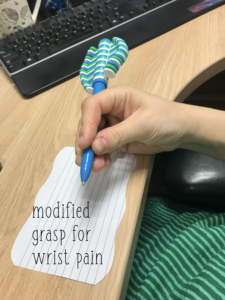
Some children write with a “thumb wrap” grip, which means they are usually controlling the movements of their pencil more with their thumb.
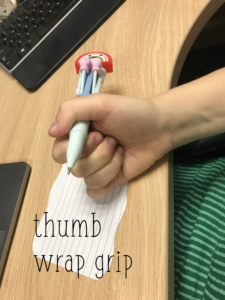
Some write with unusual ways of grasping with the fingertips.
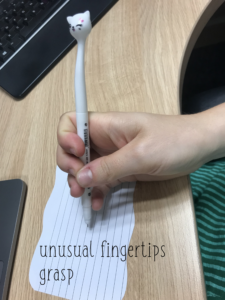
If a young, emerging writer is starting to use one of these unusual grasps, sometimes it can be helpful to introduce a pencil gripper or point out that there are more ergonomic ways to hold pencils that might avoid them ever developing pain or fatigue. But when I meet older children who are already using one of these unusual grasps, there’s usually very little point in trying to correct it unless they are also already aware that it’s causing pain or fatigue and they would like something about that to change. (Shockingly, changing something in a human being’s life is more successful when the human being, as a partner in their own care, would like it to change. 
I do recommend using half-pencils and having small utensils available to children of many ages simply because it does, in fact, take less effort to control a hand-sized utensil than it does to control a long, unwieldy utensil. I almost always recommend making them available, not making them required. Everyone’s bodies are different. Everyone has different things that feel best inside their body. For a child with a very poor sense of “body in space”, who struggles to feel physically, sensorily grounded, and appears very clumsy or uses the wrong amount of pressure to write (too little or too much) — a heavy, big, clunky utensil might actually help because the weight of it helps their brain know where their hands are, and how best to control their hands. So taking away all full-size pencils and markers and only requiring them to use tiny ones might lead to that very light-pressure writing. Experiment. Play. Make materials available and encourage kids to try them all.
So, to sum up: Teaching pencil grasp to very young children does not mean that they have the muscle support and joint control that they need to write with that tripod grasp, any more than propping up a baby on their feet is a shortcut to them having the muscles in their thighs and legs and stability in their hips that they need to stand and walk.
Children develop that muscle support and joint control through hours and hours and hours of playing with their hands, arms, fingers, wrists, shoulders. Hanging from things, climbing up things, holding up their own body weight on a bar or playground equipment or trees. Digging and poking and picking apart and ripping and snapping together and buttoning and zipping and pushing and pulling and squeezing and squishing. This is not me being idyllic or poetic. This is me literally describing biomechanically how children’s joints and muscles get ready for controlling a writing utensil to make teeny tiny little writing movements. You cannot skip the play and teach a pencil grasp and short-cut to the end result.
I did not purchase a single one of these pens for myself, so don’t ask me where I got them. Turns out that if you’re quirky and eccentric and you own like, two quirky and eccentric pens, sometimes people will start buying you weird pens that they see and giving them to you. 10/10 would recommend. 

